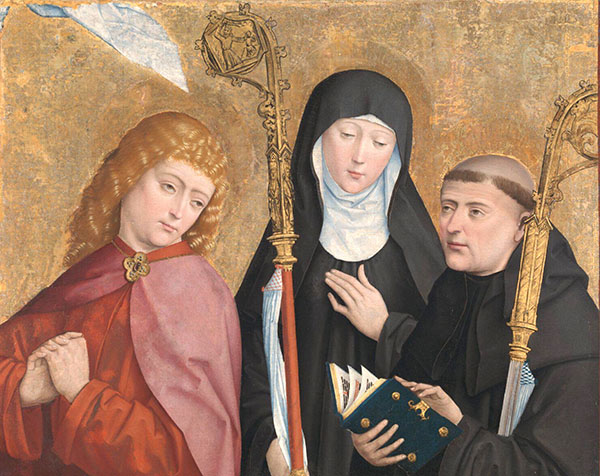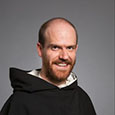Saints John the Evangelist, Scholastica, and Benedict (1470–1480), Master of Liesborn
- FATHER GABRIEL TORRETTA
Early morning, February 10. End of the 15th century. Monks file into the abbey church at Liesborn for the first prayers of the day.

The bitter winter cold reigns as triumphantly inside the church as outside it, but the mastery of the earth's darkness is broken by the array of candles lit in honor of Saint Scholastica, the sister of Saint Benedict, whose Rule guides the monks' lives. As their prayers begin, all turn toward the glorious new altarpiece that fills the sanctuary: Christ on the cross flanked by the Virgin Mary, Cosmas, and Damian on the left, and John the Evangelist, Scholastica, and Benedict on the right, all shining out against a ground of gold leaf that turns flickering candlelight into heavenly splendor.
Reformed by beauty
Liesborn Abbey had not always been marked by such earnest devotion. In the early 12th century, a congregation of nuns dwelling there had been found to be so corrupt that they were exiled from the abbey, replaced by a group of male Benedictines. By the early 15th century the men too had lost their way, leaving the choir stalls mostly empty as they pursued private business interests elsewhere. But in 1465, the abbey joined a reforming congregation of Benedictines after electing a new abbot, who labored to restore a love for the Eucharist and the Rule of Saint Benedict. Central to his program was the artistic renewal of the abbey and its church. One work above all fostered and gave expression to the abbey's new zeal for holiness: the altarpiece.
A visual Gospel
The anonymous Master of Liesborn who created this treasure has done something unexpected with the orientation of its figures. Mary and John stand on either side of the crucified Christ, in keeping with the conventional artistic adaptation of John's crucifixion narrative, yet — unusually — they do not look at Christ. Mary turns her gaze to Cosmas and Damian, and likewise here we see John's hands folded in devout contemplation of the mystery of the cross, yet his eyes are turned definitively toward Scholastica and Benedict. John in effect physically re-enacts the writing of his Gospel: rapt in love for Christ and drawn into the glory of the cross, John turns to the Church and hands on what he has seen in the pierced heart of Christ.
The Master of Liesborn portrays Scholastica living out the glory to which every Christian is called, to share in the vocation of the Mother of God by conceiving him interiorly.
Scholastica and Benedict receive his gift, and their creation of the male and female branches of the Benedictine Order is unveiled to be a bodily living-out of the Beloved Disciple's contemplative love. Scholastica's crozier underscores the point, bearing a miniature depiction of Abraham's sacrifice of Isaac, a scene which reveals how God's merciful love shatters the limits of human expectations. An eternal wind catches the loose end of Christ's loincloth, interposing it between John's head and the image on Scholastica's crozier. The cross, we see, is the heart of the Gospel and so the heart of religious life.
Conceiving Christ
Benedict's pose is easy to read: eyes open and intent, he looks up to the cross, holding in his hands an elegant book with black and red lettering — possibly a breviary for the monastic hours, perhaps more likely a copy of the Rule he wrote that changed the face of Western monasticism forever. But Scholastica's pose may be harder for the modern viewer to grasp: eyes downcast, head turned slightly away from the cross, she seems to belong to a different scene entirely. Yet that mysterious pose reveals a dignity that may outstrip Benedict's or even John's, for Scholastica perfectly mirrors a rich artistic tradition of depicting the Virgin Mary at the moment of the Annunciation: eyes lowered in humility, hand pressed simply to her chest, she turns her attention not to what is happening outside, but to what God is doing within. The Master of Liesborn portrays Scholastica living out the glory to which every Christian is called, to share in the vocation of the Mother of God by conceiving him interiorly. Scholastica receives all the graces that come to her from the cross and from the arduous splendor of her monastic life, and lets not a crumb of them drop from her fingers. She keeps all these things, pondering them in her heart (Lk 2:19).
The beauty of the Eucharist
The luminous flesh, lavish drapery, and radiant gold leaf that characterize the work do more than simply attract the eye. An invisible beauty floods the scene and gives it its richness, a beauty that may at times be forgotten but refuses to stay hidden: the beauty of the Eucharist. The Master of Liesborn gave his monastic viewers a sensory means to experience the glory of the flesh of God, veiled under the appearance of the Eucharistic host but unveiled to the eyes in the holiness of the saints whom they spent their lives striving to imitate. Amid the clouds of incense and the words of the Mass offered in her honor every tenth of February, Scholastica's image remained poised in pregnant expectation, manifesting to all what glory comes from a life spent receiving and contemplating the Eucharist: for he who is mighty has done great things for me, and holy is his name (Lk 1:49).
Liesborn Abbey did not long preserve the restored zeal symbolized by its splendid altarpiece. Wracked by the upheavals of the 16th century, the monastery tumbled into dissolution until it was seized and disbanded by the state at the beginning of the 19th century, after which the altarpiece was cut into pieces and sent hither and yon. But even now this fragment of its glory can catch the flickering light of our faith and magnify it into a celestial radiance. The cold and the darkness of the night do not triumph. We too can be reformed by beauty.
 This is Meaghen Gonzalez, Editor of CERC. I hope you appreciated this piece. We curate these articles especially for believers like you.
This is Meaghen Gonzalez, Editor of CERC. I hope you appreciated this piece. We curate these articles especially for believers like you.
Please show your appreciation by making a $3 donation. CERC is entirely reader supported.

Acknowledgement
Father Gabriel Torretta, "Saints John the Evangelist, Scholastica, and Benedict (1470–1480), Master of Liesborn." Magnificat (February 2021).
Reprinted with permission of Magnificat
The Author
 Father Gabriel Torretta, O.P. is a Dominican priest of the Province of Saint Joseph and doctoral student at the University of Chicago.
Father Gabriel Torretta, O.P. is a Dominican priest of the Province of Saint Joseph and doctoral student at the University of Chicago.




